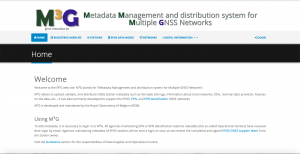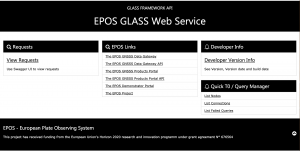a new way of accessing GNSS data and products for Solid Earth Science researchers
This page provides useful links for data providers (agencies) to submit the log files of their GNSS stations and to download the GLASS software package to disseminate their GNSS data.




M3G Portal – M3G stands for “Metadata Management and distribution system for Multiple GNSS Networks”. M3G allows to upload, validate, and distribute GNSS station metadata such as IGS-style site logs, information about local networks, DOIs, nominal data provision, licenses on the data, etc… It has been primarily developed to support the EPOS, EPN, and EPN densification GNSS networks. M3G is developed and maintained by the Royal Observatory of Belgium (ROB).
Metadata – Station metadata is the chronological description of the equipment at a GNSS station. Incorrect station metadata can cause errors in the computed coordinate positions. To avoid such errors, it is important that the researcher who analyses the GNSS data from the station has access to the full set of station metadata. Each data supplier must make sure that the metadata of its GNSS stations are properly maintained. The TCS GNSS developed a dedicated tool (M3G) for this.
EPOS Data Supplier Letter – It is a major step towards the implementation of EPOS’s legal project. The signed letter is a protocol stating that the agency owning the data agrees to make its GNSS data and metadata (site log files) available to EPOS and that these data can be disseminated under the Creative Commons 4.0 CC:BY license. The latter ensures that the data will be open access, in line with the guidelines of the European commission. Foreseeing all legal aspects, once signed, this EPOS Supplier Letter guarantees that the name of the data supplier will be attached to the data, giving proper credit to the data source. Furthermore, one of the major benefits is that EPOS will validate the metadata and the GNSS data and provide feedback and the data supplier can install GLASS or get a license to send the data to an existing GLASS node from which the data will made it accessible for download from the EPOS GNSS data gateway. Last, but not least, it will be possible to get regular updates on who has been downloading the data.
Join us by signing the supplier letter @ https://gnss-metadata.eu/Guidelines/EPOS-GNSS_Supplier_Letter.docx.
Procedure for including GNSS stations in EPOS @ https://gnss-metadata.eu/Guidelines/EPOS-GNSS_Procedure_for_EPOS_Stations.pdf.
More information on using M3G @ https://gnss-metadata.eu/.
Virtual Machine – To distribute the software to the various partners, the UBI team has put together a virtual machine, or simply VM, with most of the software that all partners have been developing pre-compiled and installed. The virtual machine has been developed using Vagrant which is a wrapper for building and managing virtual machines. In this particular case, the virtual machine was created using the Oracle VirtualBox engine.
How to use VM – Add the Box file to Vagrant, boot it up, configure the network, access the virtual machine and in the terminal type ‘startglass’ to execute a standard startup script. Once the start-up process is completed you should be able to fully use all the processing and visualization capabilities that were inserted in the VM. Be aware that as each site (node) where GNSS station data is managed is different it still means that the configuration of many parameters cannot be avoided.
Usefulness – The GLASS virtual machine is very useful for developing and testing purposes and for getting to know all the software from WP10, and this is its prime purpose, it is an alternative to the download, compilation and configuration of all the individual packages and dependencies. The VM is therefore very useful in the scope of developing, testing and training. The VM can also be used in a production environment for managing data from networks of GNSS stations, after suitable security precautions are taken into consideration, such a turn key solution may be desirable and the UBI team will work towards this goal.
Tools installed on the virtual machine – The VM contains the following core tools necessary for a Glass Node installation (between parentheses is the partner who was largely responsible for the development):
- The Database schema necessary for storing all metadata (UBI)
- IndexGD tool for indexing RINEX files (OCA)
- DB-API tool for inserting metadata, site logs, Rinex files, in the DB. (UBI/INGV and OCA)
- GlassFramework API tool that serves the metadata stored in the database (UBI)
- Anubis and RunQC tools to check the quality of the GNSS data (GOP)
- Synchronization system tool to synchronize metadata between nodes (UBI)
- Monitor Data Gateway (DGW) tools to control interaction between M3G and the data gateway (OCA)
Graphical Web Applications – The VM also contains Graphical Web Applications to help in visualization and administration:
- Glass Web Client GUI to visualize metadata stored in DB (OCA)
- Products Portal GUI to visualize GNSS data derived products (UBI)
- Node Manager GUI to manage the local node information (UBI)
Set of tools – With this set of tools, it is possible to fully to manage the functionality of the nodes. It is possible to insert new metadata, visualize all the data and metadata inserted in the database, check the quality of the data and interact with other testing partners using the synchronization tools.
Virtualization – In terms of future work concerning virtualization, the UBI group is currently working on a more lightweight, approach using Docker containers, thereby giving developers and deployers more options when considering the installation of software components from WP10.
The Virtual Machine and its software are, however, not the only step necessary to join the EPOS network. Information about stations and networks that are being offered must be previously inserted using the M3G portal, which is a dedicated tool where each data supplier must make sure that the metadata of its GNSS stations are properly maintained.
Metadata – Station metadata is the chronological description of the equipment at a GNSS station. Incorrect station metadata can cause errors in the computed coordinate positions. To avoid such errors, it is important that the researcher who analyses the GNSS data from the station has access to the full set of station metadata. Each data supplier must make sure that the metadata of its GNSS stations are properly maintained. The TCS GNSS developed a dedicated tool (M3G) for this.
M3G Portal – M3G stands for “Metadata Management and distribution system for Multiple GNSS Networks”. M3G allows to upload, validate, and distribute GNSS station metadata such as IGS-style site logs, information about local networks, DOIs, nominal data provision, licenses on the data, etc… It has been primarily developed to support the EPOS, EPN, and EPN densification GNSS networks. M3G is developed and maintained by the Royal Observatory of Belgium (ROB).
More information on using and obtaining the virtual machine @ https://www.c4g-pt.eu/eposvm/.